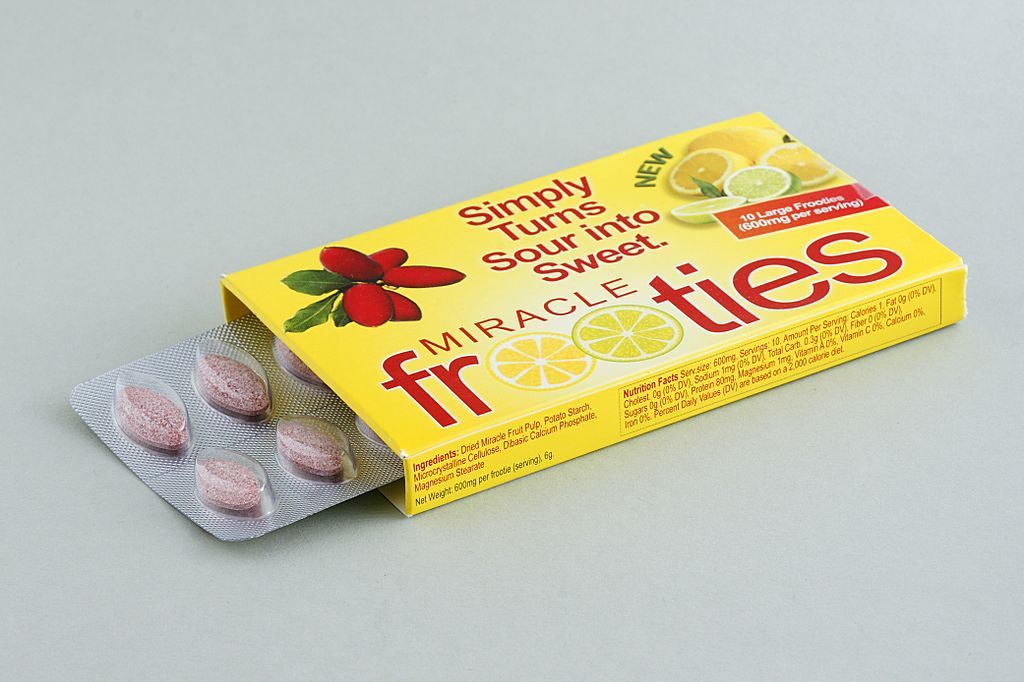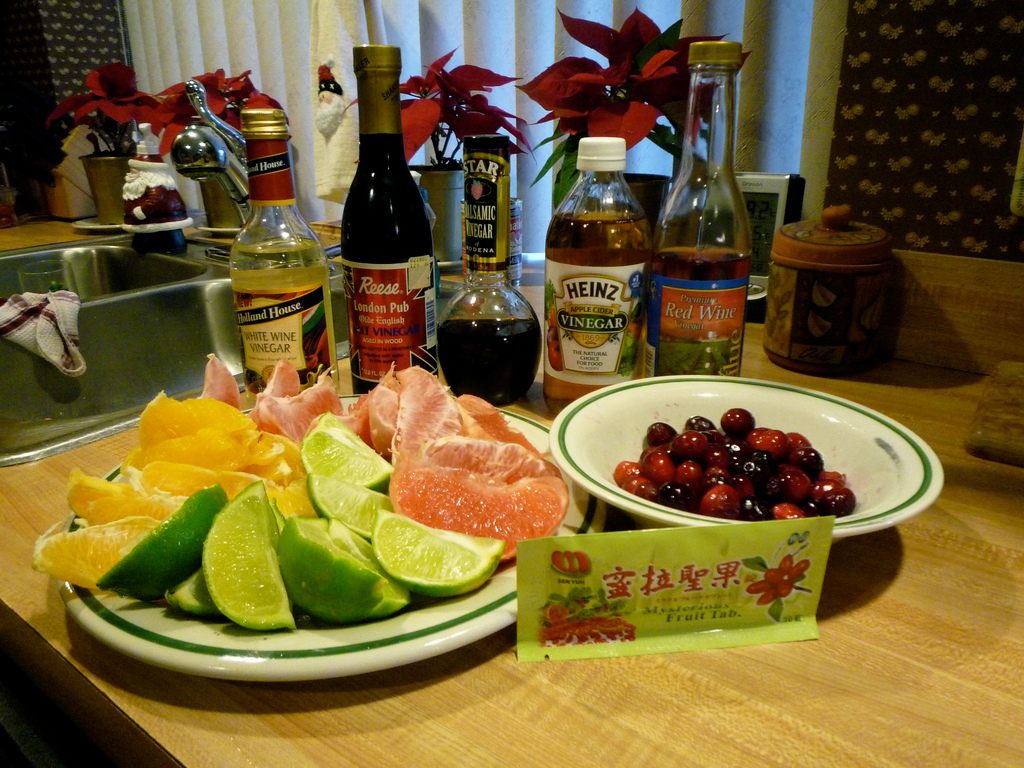The Miracle Sugar Substitute The FDA Won’t Let You Have

Miracle berry tablets. (Photo: Alexander Klink/WikiCommons)
If you have any kind of sweet tooth, the miracle berry really lives up to its name.
When you eat this West African fruit, or let a tablet of freeze-dried miracle berry dissolve on your tongue, sour things taste intensely sweet and delicious for as much as two hours. The more sour and acidic a food, the sweeter it tastes—straight lemon and lime juice are especially popular at “flavor-tripping” parties, where guests eat miracle berries and then cram everything in existence into their mouths—but even foods with a hint of tartness, like goat cheese, turn into desserts. The miracle comes from a protein called miraculin, which binds to the taste buds that recognize sweetness, making them easily activated by low-pH foods.
With that kind of natural sweetening power, miracle berries could be a bona fide miracle for people who have diabetes, or who just want to cut down on refined sugar, but who want to avoid nutritionally questionable man-made chemicals like aspartame. And indeed, in the 1960s biomedical student Robert Harvey developed just that product. It was to be a ground-breaking use of the berry, blockbuster all-natural additive. By 1974, Harvey’s company, Miralin, was poised to make miracle berries the sugar substitute of America’s dreams.
And yet today, instead of revolutionizing sugar-free products, the berries have been relegated to novelty status. The miracle berry has flirted with high cuisine; Chicago chef Homaro Cantu, who died unexpectedly earlier this year, incorporated the fruit into the menu at his coffeeshop Berrista. (If you can’t make it to Chicago, and you missed the miracle berry tasting menu at Cantu’s molecular gastronomy restaurant iNG, you can also buy his cookbook.) But most of the time, the fruit’s highest aspiration is a sort of super-low-key gustatory Burning Man: people buy a ten-pack of tablets off Amazon, or have some frozen fruits shipped overnight from Florida, and spend a fun evening with friends flipping out over how good everything tastes. Not exactly the new margarine.
So what happened? How did miraculin go from game-changer to party trick? The answer is a shady tale of government obstructionism and maybe even a little corporate espionage.

Preparations for a flavor-tripping party. (Photo: Jason Eppink/flickr)
In the early 1970s, everything was going Miralin’s way. Harvey had intended to market his miraculin extract to diabetics, and the FDA was on board; an extensive toxicology study had shown that miracle berry concentrate had no negative effects on rats, even at massive doses. But Miralin had big investors lined up—aluminum foil giant Reynolds, Barclays bank, Prudential insurance—who wanted to see an even bigger reach. So Harvey and Miralin vice president Don Emery handed out miraculin-sweetened ice pops to Boston schoolchildren, and found that the kids liked them even better than similar ones made with sugar.
It seemed like miraculin had the potential to revolutionize not only sugar-free products, but the whole food industry. “If we had got beyond the diabetic market we could have been a multi-billion dollar company,” Emery told the BBC in 2008. “We’d have displaced maybe millions of tons of sugar and lots of artificial sweeteners as well.”
But not too long after the ice pop experiment, things got weird. Harvey says he was followed home from work by a car that was clearly tracking his movements. Another car reportedly drove back and forth in front of Miralin headquarters, taking pictures. Finally, Harvey and Emery say, there was the day that they came in to the office late in the evening and interrupted a burglary. The intruders ran away, but Harvey and Emery say the files were ransacked—and the FDA file was left conspicuously open on the floor. Nor was this an ordinary breaking and entering; none of the building’s locks had been destroyed.
Shortly afterwards, just as Miralin’s products were about to launch, the FDA abruptly announced that miraculin would be considered a food additive, requiring extensive—and expensive—testing for approval. Harvey had believed (and says he had been led to believe by the FDA) that the berry-derived protein would be classified “generally recognized as safe,” as befits a fruit that’s been eaten for centuries without incident. The change in status to “food additive” was financially devastating; even with its corporate backing, Miralin couldn’t afford the testing necessary to wrangle FDA approval. The miracle berry sweetener was dead in the water.
According to Don Emery, the suspicious events and the FDA’s about-face are clearly connected. “I honestly believe that we were done in by some industrial interest that did not want to see us survive because we were a threat. Somebody influenced somebody in the FDA to cause the regulatory action that was taken against us,” he told the BBC. Miraculin-loving chef Homaro Cantu agreed, pointing out in the Huffington Post that Miralin’s main competitor at the time was a company called GD Searle, which pushed its sweetener aspartame through FDA approval via potentially shady means. “The FDA commissioner that was inserted just long enough to label miracle berries as a food additive and push aspartame through regulation was accused of allegedly accepting corporate bribes,” Cantu wrote. (The aspartame approval was widely criticized and later revoked; aspartame was re-approved in 1981.)
Conspiracy theorists, take note: GD Searle at the time was headed by none other than Donald Rumsfeld.
It’s hard to know what really happened. The Sugar Association, the main sugar trade group, says it did not influence the FDA about miraculin. Harvey says he tried to obtain a copy of the FDA’s files, but that it was heavily redacted and uninformative. The FDA told the Atlantic that “The FDA has not received further information on the safety of the use of this substance in food under either the GRAS program or a food additive petition,” which translates to “¯\_(ツ)_/¯.” At any rate, Miralin filed for bankruptcy. A company called BioResources International took up the gauntlet in 1999, but it did not manage to get its miraculin extract approved as a dietary supplement, and the company’s website has not been updated since 2005.

Miracle berries on the bush. (Photo: MiracleFruitFarm/WikiCommons)
Is there any hope for the miracle berry as an industry, beyond the one guy who’s reportedly charged $15 a head for flavor-tripping parties? Without FDA backing, it probably won’t go any bigger than the independent farms that sell berries in bulk. It’s legal to buy whole berries, or powdered ones, and to sell them in your restaurant or cafe, but you can’t distribute miraculin-containing products in the U.S.
Before his death, Homaro Cantu, the miraculin-loving chef, was working with indoor miracle berry farms that he said could make miraculin cheaper and more energy-efficient than sugar. He hoped to partner up with major producers of sweets and soda, forming an alliance that even the FDA wouldn’t deny. It never happened, but that doesn’t mean it never will.
In the meantime, even if miracle berries won’t be revolutionizing the food industry anytime soon, they can still revolutionize your personal palate. You can get 300 dried or fresh ones for $1.20 each, or pay a little more per unit for a smaller shipment. A pack of 10 tablets will set you back about $15. You can even get your own plant for $30 (or a bigger one for $90) if you live in a warm, humid place. Put a little lemon juice in your coffee, as Cantu has suggested, pop a berry in your mouth, and contemplate how close this country came to kicking sugar for good.
Gastro Obscura covers the world’s most wondrous food and drink.
Sign up for our regular newsletter.
























Follow us on Twitter to get the latest on the world's hidden wonders.
Like us on Facebook to get the latest on the world's hidden wonders.
Follow us on Twitter Like us on Facebook